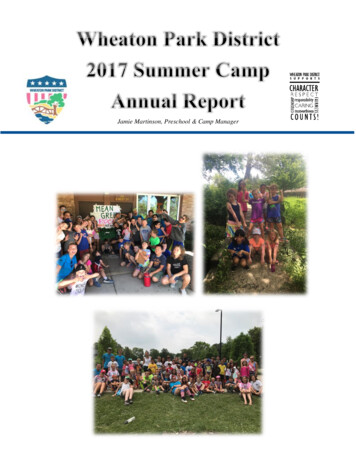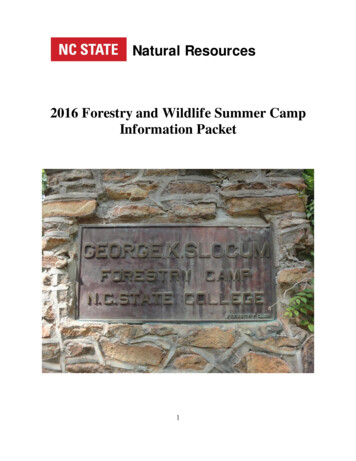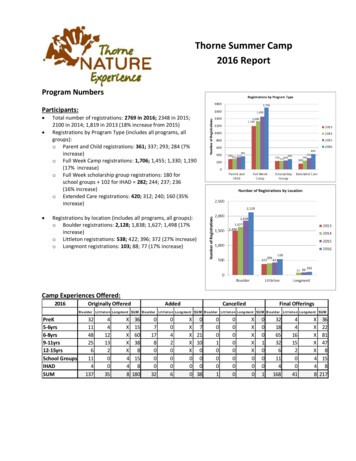Transcription
B3 Summer Science Camp2016
26/28/2016The overlapping amplicon approach to CP genomerecovery and sequencing The Chloroplast genome is 160,000bp long. The longest PCR wecan carry out very well is 20,000bp.The overlaps are to let me arrange the pieces correctly, since Icannot ‘number’ them.Weller UNCC
36/28/2016Dr. Weller B3 Olympic HS Summer
46/28/2016Dr. Weller B3 Olympic HS Summer
56/28/2016Dr. Weller B3 Olympic HS Summer
66/28/2016Dr. Weller B3 Olympic HS Summer
76/28/2016Gene Annotation in GraphicsViewDr. Weller B3 Olympic HS Summer
8PCR Assay Design Constraints Specificity:did primers amplify an unintended locus?What if your genome has a SNP where the primer binds? If the length is correct: sequence or restrict the product
9Fragmenting the long amplicons The sequencer cannot handle fragments that are longer than 600bp long. So once I have made the long amplicons I haveto break them into much smaller pieces.The sequencer requires known ends on every fragment – one is to act asan anchor to hold the fragment in place, and the other lets a primer bindso DNA polymerase can attach and make a copy of the fragment – thisis what gives us the sequence.
106/28/2016Enzymatic Fragmentation of Nucleic acids Some degree of sequence specificity results.REs: specificity is as precise as the recognition sitedsDNA is the required substrateWith DNAaseI, MNase, etc there is sequence preference butnot specificity.Weller UNCC
116/28/2016Transposase method (Nextera)From: EpiBio.conWeller UNCC
12Transposase Anenzyme that binds to the end of a piece of DNAcalled a transposon, and helps it insert the DNA into themiddle of another piece of DNA.
13Transposase Thetransposing element moves as a physical entitydirectly from one site to another, and is conserved.
14Transposase – modified for sequencing
156/28/2016Notes on size selection – the bead lab After cutting up the DNA with a restrictionenzyme – how do we select just the ones in thesize range that works for sequencing?Cut a band out of the gel, try to extract the DNAUse selective precipitation of DNA onto AmpureXP magnetic beads.Beads should be at room temperature andethanol wash solution should be made fresh. Remove the adaptors and things that are too short:now increase the Beads/PEG in the Supernatant.1:8 means fragments 100bp are ON THEBEADS – keep these.Elute the DNA from the beads and quantify theremainder.Weller UNCC
166/28/2016Prep notes Solubility is very temperature dependentBeads should be at room temperatureEthanol will absorb water from the air, whichchanges the concentration over time – make itup fresh each day.Ethanol and water change each other’svolume when mixed – when you make thesolution measure each separately and thencombine them.Weller UNCC
176/28/2016Prep notes Polyethyleneglycol is used to ‘crowd’the DNA out of solution – the beadsprovide a convenient surface for theDNA to land. At a high ratio of PEG, most DNA willbe crowded onto the beads – only smallthings are in the solution.At a low ratio of beads only very bigDNA is crowded onto the beads,medium and small DNA fragments willbe in solution. Toget back what is on the beads:remove the PEG and add water – theDNA dissolves back off the bead (thisis called elution).Weller UNCC
AMPure XP beads The bead creates a large surface area for DNA to precipitate onto 6/28/2016The bead is coated with carboxyl groups (net negative charge) - thismeans the DNA won’t stick so hard it does not come off.The beads are in a solution of 20% polyethylene glycol (PEG)which has been used to precipitate DNA since 1975 (Lis andSchleif) by crowding it out of solution.Dr. Weller UNCC
AMPure XP beads 6/28/2016Higher mw DNA precipitates at lower conc of PEG. Theyused 5% - 15% PEG in 10mM Tris pH 7.5 with 2mM EDTA. At 0.35M NaCl high mw DNA was ppt by 12% PEG. At 0.55M the 700bp DNA was ppt in 6.5% PEG and at 1.1M NaClDNA 375bp was ppt by 6.5% PEG. At 12% PEG, 0.55M ppt 125bp and at 1.1M NaCl 80bp. Conclusion: small polynucleotides require a higher [salt] forstrong binding to the beads, so salt can be used to manipulate therelease of the DNA.Dr. Weller UNCC
The beads 6/28/2016XP beads are paramagnetic (magnetite sealed witha polymer that has the carboxylic groups on it) sothey will stick to magnets.The buffer used has polyethylene glycol (PEG)8000 in it (20%) and the salt is 2.5M NaCl.Binding capacity is supposed to be 2ug/100ug ofbeads, but you don’t usually get to know howmany beads you have, instead you use a volume ofbead suspension.A free agent noted that using 10% PEG 8000 with1.25M NaCl and 10mM MgCl2 gave ppt resultssimilar to the yield with Ampure XP beads. If 7% PEG was used a lot of 50 and 100bp DNAwas lost but the 200bp product (and greater) wasnearly quantitative.Dr. Weller UNCC
B3 Summer Science Camp 2016. . The overlaps are to let me arrange the pieces correctly, since I cannot 'number' them. 6/28/2016 Weller UNCC 2. 6/28/2016 Dr. Weller B3 Olympic HS Summer 3. 6/28/2016 Dr. Weller B3 Olympic HS Summer 4. . Gene Annotation in Graphics View 6/28/2016 Dr. Weller B3 Olympic HS Summer 7.










